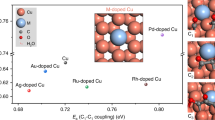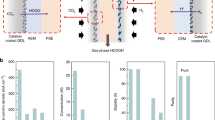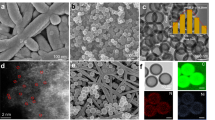Abstract
Solid oxide fuel cells (SOFCs) are potentially the most efficient technology for direct conversion of hydrocarbons to electricity. While their commercial viability is greatest at operating temperatures of 300–500 °C, it is extremely difficult to run SOFCs on methane at these temperatures, where oxygen reduction and C–H activation are notoriously sluggish. Here we report a robust SOFC that enabled direct utilization of nearly dry methane (with ~3.5% H2O) at 500 °C (achieving a peak power density of 0.37 W cm−2) with no evidence of coking after ~550 h operation. The cell consists of a PrBa0.5Sr0.5Co1.5Fe0.5O5+δ nanofibre-based cathode and a BaZr0.1Ce0.7Y0.1Yb0.1O3–δ-based multifunctional anode coated with Ce0.90Ni0.05Ru0.05O2 (CNR) catalyst for reforming of CH4 to H2 and CO. The high activity and coking resistance of the CNR is attributed to a synergistic effect of cationic Ni and Ru sites anchored on the CNR surface, as confirmed by in situ/operando experiments and computations.
This is a preview of subscription content, access via your institution
Access options
Access Nature and 54 other Nature Portfolio journals
Get Nature+, our best-value online-access subscription
$29.99 / 30 days
cancel any time
Subscribe to this journal
Receive 12 digital issues and online access to articles
$119.00 per year
only $9.92 per issue
Buy this article
- Purchase on Springer Link
- Instant access to full article PDF
Prices may be subject to local taxes which are calculated during checkout





Similar content being viewed by others
Data availability
The data that support the plots within this paper and other findings of this study are available from the corresponding author upon reasonable request.
References
Liu, M., Lynch, M. E., Blinn, K., Alamgir, F. M. & Choi, Y. Rational SOFC material design: new advances and tools. Mater. Today 14, 534–546 (2011).
Shao, Z. et al. Electric power and synthesis gas co-generation from methane with zero waste gas emission. Angew. Chem. Int. Ed. 50, 1792–1797 (2011).
Shao, Z. & Haile, S. M. A high-performance cathode for the next generation of solid-oxide fuel cells. Nature 431, 170–173 (2004).
Duan, C. et al. Readily processed protonic ceramic fuel cells with high performance at low temperatures. Science 349, 1321–1326 (2015).
Murray, E. P., Tsai, T. & Barnett, S. A. A direct-methane fuel cell with a ceria-based anode. Nature 400, 649–651 (1999).
Hashimoto, K., Watase, S. & Toukai, N. Reforming of methane with carbon dioxide over a catalyst consisting of ruthenium metal and cerium oxide supported on mordenite. Catal. Lett. 80, 147–152 (2002).
Derk, A. R., Moore, G. M., Sharma, S., McFarland, E. W. & Metiu, H. Catalytic dry reforming of methane on ruthenium-doped ceria and ruthenium supported on ceria. Top. Catal. 57, 118–124 (2014).
Safariamin, M., Tidahy, L. H., Abi-Aad, E., Siffert, S. & Aboukaïs, A. Dry reforming of methane in the presence of ruthenium-based catalysts. C. R. Chim. 12, 748–753 (2009).
Zhang, S., Muratsugu, S., Ishiguro, N. & Tada, M. Ceria-doped Ni/SBA-16 catalysts for dry reforming of methane. ACS Catal. 3, 1855–1864 (2013).
Kambolis, A., Matralis, H., Trovarelli, A. & Papadopoulou, C. Ni/CeO2-ZrO2 catalysts for the dry reforming of methane. Appl. Catal. A 377, 16–26 (2010).
Adler, S. B. Factors governing oxygen reduction in solid oxide fuel cell cathodes. Chem. Rev. 104, 4791–4844 (2004).
Jiang, S. P. Nanoscale and nano-structured electrodes of solid oxide fuel cells by infiltration: Advances and challenges. Int. J. Hydrogen Energy 37, 449–470 (2012).
Arico, A. S., Bruce, P., Scrosati, B., Tarascon, J. M. & van Schalkwijk, W. Nanostructured materials for advanced energy conversion and storage devices. Nat. Mater. 4, 366–377 (2005).
Zhi, M., Lee, S., Miller, N., Menzler, N. H. & Wu, N. An intermediate-temperature solid oxide fuel cell with electrospun nanofiber cathode. Energy Environ. Sci. 5, 7066–7071 (2012).
Lee, J. G., Park, J. H. & Shul, Y. G., Tailoring gadolinium-doped ceria-based solid oxide fuel cells to achieve 2 W cm−2 at 550 °C. Nat Commun. 5, 4045 (2014).
Chen, Y. et al. A robust and active hybrid catalyst for facile oxygen reduction in solid oxide fuel cells. Energy Environ. Sci. 10, 964–971 (2017).
Chen, Y. et al. A highly efficient and robust nanofiber cathode for solid oxide fuel cells. Adv. Energy Mater. 7, 1601890 (2017).
Chen, Y. et al. A highly efficient multi-phase catalyst dramatically enhances the rate of oxygen reduction. Joule 2, 938–949 (2018).
Tang, Y. et al. Single rhodium atoms anchored in micropores for efficient transformation of methane under mild conditions. Nat. Commun. 9, 1231 (2018).
Zhang, S. R. et al. Catalysis on singly dispersed bimetallic sites. Nat. Commun. 6, 7938 (2015).
Zhu, Y. et al. Catalytic conversion of carbon dioxide to methane on ruthenium–cobalt bimetallic nanocatalysts and correlation between surface chemistry of catalysts under reaction conditions and catalytic performances. ACS Catal. 2, 2403–2408 (2012).
Tao, F. F. et al. Understanding complete oxidation of methane on spinel oxides at a molecular level. Nat. Commun. 6, 7798 (2015).
Shan, J. J. et al. Conversion of methane to methanol with a bent mono(mu-oxo)dinickel anchored on the internal surfaces of micropores. Langmuir 30, 8558–8569 (2014).
Rainwater, B. H., Liu, M. & Liu, M. A more efficient anode microstructure for SOFCs based on proton conductors. Int. J. Hydrogen Energy 37, 18342–18348 (2012).
Zhu, W., Xia, C., Fan, J., Peng, R. & Meng, G. Ceria coated Ni as anodes for direct utilization of methane in low-temperature solid oxide fuel cells. J. Power Sources 160, 897–902 (2006).
Somorjai, G. A. & Li, Y. Introduction of Surface Chemistry and Catalysis (Wiley-VCH, 2010).
Ertl, G. Reactions at Solid Surfaces (John Wiley & Sons, 2010).
Nguyen, L. & Tao, F. Development of a reaction cell for in-situ/operando studies of surface of a catalyst under a reaction condition and during catalysis. Rev. Sci. Instrum. 87, 064101 (2016).
Nguyen, L. et al. Dual reactor for in situ/operando fluorescent mode XAS studies of sample containing low-concentration 3d or 5d metal elements. Rev. Sci. Instrum. 89, 054103 (2018).
Nguyen, L. & Tao, F. Reactor for tracking catalyst nanoparticles in liquid at high temperature under a high-pressure gas phase with X-ray absorption spectroscopy. Rev. Sci. Instrum. 89, 024102 (2018).
Anspoks, A., Kalinko, A., Kalendarev, R. & Kuzmin, A. Atomic structure relaxation in nanocrystalline NiO studied by EXAFS spectroscopy: Role of nickel vacancies. Phys. Rev. B 86, 174114 (2012).
Peck, M. A. & Langell, M. A. Comparison of nanoscaled and bulk NiO structural and environmental characteristics by XRD, XAFS, and XPS. Chem. Mater. 24, 4483–4490 (2012).
Huang, P. C. et al. Oxidation triggered atomic restructures enhancing the electrooxidation activities of carbon supported platinum–ruthenium catalysts. CrystEngComm 16, 10066–10079 (2014).
Arikawa, T., Takasu, Y., Murakami, Y., Asakura, K. & Iwasawa, Y. Characterization of the structure of RuO2−IrO2/Ti electrodes by EXAFS. J. Phys. Chem. B 102, 3736–3741 (1998).
Yi, N. et al. Highly efficient Ni–Ce–O mixed oxide catalysts via gel-coprecipitation of oxalate precursors for catalytic combustion of methane. Chem. Lett. 34, 108–109 (2005).
Roh, H. S., Potdar, H. & Jun, K. W. Carbon dioxide reforming of methane over co-precipitated Ni–CeO2, Ni–ZrO2 and Ni–Ce–ZrO2 catalysts. Catal. Today 93, 39–44 (2004).
Chastain, J., King, R. C. & Moulder, J. Handbook of X-ray Photoelectron Spectroscopy: A Reference Book of Standard Spectra for Identification and Interpretation of XPS Data (Physical Electronics Division, Perkin-Elmer Corporation Eden Prairie, Minnesota, 1992).
Morgan, D. J. Resolving ruthenium: XPS studies of common ruthenium materials. Surf. Interface Anal. 47, 1072–1079 (2015).
Lustemberg, P. G. et al. Room-temperature activation of methane and dry re-forming with CO2 on Ni-CeO2(111) surfaces: effect of Ce3+ sites and metal–support interactions on C–H bond cleavage. ACS Catal. 6, 8184–8191 (2016).
Zhu, Y. et al. In situ surface chemistries and catalytic performances of ceria doped with palladium, platinum, and rhodium in methane partial oxidation for the production of syngas. ACS Catal. 3, 2627–2639 (2013).
Fung, V., Tao, F. F. & Jiang, D. E. General structure-reactivity relationship for oxygen on transition-metal oxides. J. Phys. Chem. Lett. 8, 2206–2211 (2017).
Takanabe, K. et al. Integrated in situ characterization of a molten salt catalyst surface: evidence of sodium peroxide and hydroxyl radical formation. Angew. Chem. Int. Ed. 56, 10403–10407 (2017).
Zhang, X. Y. et al. Complete oxidation of methane on NiO nanoclusters supported on CeO2 nanorods through synergistic effect. ACS Sustain. Chem. Eng. 6, 6467–6477 (2018).
Huang, W. X. et al. Low-temperature transformation of methane to methanol on Pd1O4 single sites anchored on the internal surface of microporous silicate. Angew. Chem. Int. Ed. 55, 13441–13445 (2016).
Zhang, S. R. et al. In situ studies of surface of NiFe2O4 catalyst during complete oxidation of methane. Surf. Sci. 648, 156–162 (2016).
Elvington, M., Brown, J., Arachchige, S. M. & Brewer, K. J. Photocatalytic hydrogen production from water employing a Ru, Rh, Ru molecular device for photoinitiated electron collection. J. Am. Chem. Soc. 129, 10644 (2007).
Ikarashi, K. et al. Photocatalysis for water decomposition by RuO2-dispersed ZnGa2O4 with d(10) configuration. J. Phys. Chem. B 106, 9048–9053 (2002).
Iwase, A., Ng, Y. H., Ishiguro, Y., Kudo, A. & Amal, R. Reduced graphene oxide as a solid-state electron mediator in Z-scheme photocatalytic water splitting under visible light. J. Am. Chem. Soc. 133, 11054–11057 (2011).
Inagaki, A. & Akita, M. Visible-light promoted bimetallic catalysis. Coord. Chem. Rev. 254, 1220–1239 (2010).
Yang, L. et al. Enhanced sulfur and coking tolerance of a mixed ion conductor for SOFCs: BaZr0.1Ce0.7Y0.2–xYbxO3–δ. Science 326, 126–129 (2009).
Chen, Y. et al. A highly active, CO2-tolerant electrode for the oxygen reduction reaction. Energy Environ. Sci. 11, 2458–2466 (2018).
Liu, M., Ding, D., Bai, Y., He, T. & Liu, M. An efficient SOFC based on samaria-doped ceria (SDC) electrolyte. J. Electrochem. Soc. 159, B661–B665 (2012).
Sun, W., Shi, Z., Qian, J., Wang, Z. & Liu, W. In-situ formed Ce0.8Sm0.2O2−δ@Ba(Ce, Zr)1−x(Sm, Y)xO3−δ core/shell electron-blocking layer towards Ce0.8Sm0.2O2−δ-based solid oxide fuel cells with high open circuit voltages. Nano Energy 8, 305–311 (2014).
Chen, Y. et al. A durable, high-performance hollow-nanofiber cathode for intermediate-temperature fuel cells. Nano Energy 26, 90–99 (2016).
Tang, Y. et al. Transition of surface phase of cobalt oxide during CO oxidation. Phys. Chem. Chem. Phys. 20, 6440–6449 (2018).
Zhang, S. R. et al. Catalysis on singly dispersed Rh atoms anchored on an inert support. ACS Catal. 8, 110–121 (2018).
Zhang, X. Y. et al. C–C coupling on single-atom-based heterogeneous catalyst. J. Am. Chem. Soc. 140, 954–962 (2018).
Shan, J. J. et al. Tuning catalytic performance through a single or sequential post synthesis reaction(s) in a gas phase. ACS Catal. 7, 191–204 (2017).
Liu, J. J. et al. Tuning catalytic selectivity of oxidative catalysis through deposition of nonmetallic atoms in surface lattice of metal oxide. ACS Catal. 6, 4218–4228 (2016).
Nguyen, L. et al. Reduction of nitric oxide with hydrogen on catalysts of singly dispersed bimetallic sites Pt1Com and Pd1Con. ACS Catal. 6, 840–850 (2016).
Wang, L. et al. Catalysis and in situ studies of Rh1/Co3O4 nanorods in reduction of NO with H2. ACS Catal. 3, 1011–1019 (2013).
Zhang, S. R. et al. WGS catalysis and in situ studies of CoO1−x, PtCon/Co3O4, and PtmCom'/CoO1 −x nanorod catalysts. J. Am. Chem. Soc. 135, 8283–8293 (2013).
Xu, Q. et al. Efficient removal of formaldehyde by nanosized gold on well-defined CeO2 nanorods at room temperature. Environ. Sci. Tech. 48, 9702–9708 (2014).
Yeh, J. & Lindau, I. Atomic subshell photoionization cross sections and asymmetry parameters: 1 ≤ Z ≤ 103. At. Data Nucl. Data Tables 32, 1–155 (1985).
Nguyen, L. & Tao, F. Development of a reaction cell for in-situ/operando studies of surface of a catalyst under a reaction condition and during catalysis. Rev. Sci. Instrum. 87, 064101 (2016).
Mullins, D., Overbury, S. & Huntley, D. Electron spectroscopy of single crystal and polycrystalline cerium oxide surfaces. Surf. Sci. 409, 307–319 (1998).
Dou, J. et al. Complete oxidation of methane on Co3O4/CeO2 nanocomposite: a synergic effect. Catal. Today 311, 48–55 (2018).
Wen, C. et al. Water-gas shift reaction on metal nanoclusters encapsulated in mesoporous ceria studied with ambient-pressure X-ray photoelectron spectroscopy. ACS Nano 6, 9305–9313 (2012).
Ye, Y. C. et al. The role of copper in catalytic performance of a Fe-Cu-Al-O catalyst for water gas shift reaction. Chem. Commun. 49, 4385–4387 (2013).
Ravel, B. & Newville, M. ATHENA, ARTEMIS, HEPHAESTUS: data analysis for X-ray absorption spectroscopy using IFEFFIT. J. Synchrotron. Radiat. 12, 537–541 (2005).
Kresse, G. & Furthmüller, J. Efficient iterative schemes for ab initio total-energy calculations using a plane-wave basis set. Phys. Rev. B 54, 11169–11186 (1996).
Kresse, G. & Furthmüller, J. Efficiency of ab-initio total energy calculations for metals and semiconductors using a plane-wave basis set. Comp. Mater. Sci. 6, 15–50 (1996).
Kresse, G. & Hafner, J. Ab-initio molecular-dynamics simulation of the liquid-metal amorphous-semiconductor transition in germanium. Phys. Rev. B 49, 14251–14269 (1994).
Kresse, G. & Hafner, J. Ab initio molecular dynamics for liquid metals. Phys. Rev. B 47, 558–561 (1993).
Perdew, J. P., Burke, K. & Ernzerhof, M. Generalized gradient approximation made simple. Phys. Rev. Lett. 77, 3865–3868 (1996).
Kresse, G. & Joubert, D. From ultrasoft pseudopotentials to the projector augmented-wave method. Phys. Rev. B 59, 1758–1775 (1999).
Blöchl, P. E. Projector augmented-wave method. Phys. Rev. B 50, 17953–17979 (1994).
Dudarev, S. L., Botton, G. A., Savrasov, S. Y., Humphreys, C. J. & Sutton, A. P. Electron-energy-loss spectra and the structural stability of nickel oxide: an LSDA + U study. Phys. Rev. B 57, 1505–1509 (1998).
Grimme, S., Antony, J., Ehrlich, S. & Krieg, H. A consistent and accurate ab initio parametrization of density functional dispersion correction (DFT-D) for the 94 elements H-Pu. J. Chem. Phys. 132, 154104 (2010).
Michaelides, A. et al. Identification of general linear relationships between activation energies and enthalpy changes for dissociation reactions at surfaces. J. Am. Chem. Soc. 125, 3704–3705 (2003).
Liu, Z. P. & Hu, P. General rules for predicting where a catalytic reaction should occur on metal surfaces: A density functional theory study of C–H and C–O bond breaking/making on flat, stepped, and kinked metal surfaces. J. Am. Chem. Soc. 125, 1958–1967 (2003).
Alavi, A., Hu, P., Deutsch, T., Silvestrelli, P. L. & Hutter, J. CO oxidation on Pt(111): An ab initio density functional theory study. Phys. Rev. Lett. 80, 3650–3653 (1998).
Acknowledgements
This work was supported by the US Department of Energy Advanced Research Projects Agency-Energy (ARPA-E) REBELS program under award no. DE-AR0000502 and the SECA Core Technology Program under award no. DE-FE0031201. The in situ/operando studies, preparation and evaluation of catalysts and the instrumentation of AP-XPS were support by the Catalysis program, Office of Basic Energy Sciences, US Department of Energy, under grant no. DE-SC0014561, and the Division of Chemistry of the NSF under award no.1462121. A part of XAS studies were done at beam line 8-ID (ISS) of the National Synchrotron Light Source II, a US Department of Energy (DOE) Office of Science User Facility operated for the DOE Office of Science by Brookhaven National Laborotary, under Contract No. DE-SC0012704. F.F.T and Y.T. acknowledged E. Stavitski for assistance in XAS experiments.
Author information
Authors and Affiliations
Contributions
M.L. and F.F.T. conceived the concept and supervised the research. Y.C., B.d. and Y.T. contributed equally to this work. Y.C., S.Y. and L.Z. prepared the electrolyte powder. Y.C., B.d., B.Z. and J.H.K. synthesized and tested the cathode and oxygen reduction catalyst materials. Y.C., S.Y. and K.P. fabricated and tested anode-supported single cells with the anodes coated with methane reforming catalysts. Y.C. and Y.D. performed the microanalysis of the electrolyte, electrode and catalyst materials. F.F.T. conceived the concept of dual single-site catalysts of reforming methane to syngas and supervised the synthesis, test and characterization of the reforming catalyst. Y.T. and Y.W. synthesized, tested and characterized the catalysts. Z.W. and P.H. performed the DFT computations. Y.C., B.d., Y.T., F.F.T. and M.L. analysed all experimental data and wrote the paper.
Corresponding authors
Ethics declarations
Competing interests
The authors declare no competing interests.
Additional information
Publisher’s note: Springer Nature remains neutral with regard to jurisdictional claims in published maps and institutional affiliations.
Supplementary information
Supplementary Information
Supplementary notes 1–24, Supplementary figures 1–20, Supplementary tables 1–2, Supplementary references
Rights and permissions
About this article
Cite this article
Chen, Y., deGlee, B., Tang, Y. et al. A robust fuel cell operated on nearly dry methane at 500 °C enabled by synergistic thermal catalysis and electrocatalysis. Nat Energy 3, 1042–1050 (2018). https://doi.org/10.1038/s41560-018-0262-5
Received:
Accepted:
Published:
Issue Date:
DOI: https://doi.org/10.1038/s41560-018-0262-5
This article is cited by
-
Direct methane protonic ceramic fuel cells with self-assembled Ni-Rh bimetallic catalyst
Nature Communications (2023)
-
Lowering the operating temperature of protonic ceramic electrochemical cells to <450 °C
Nature Energy (2023)
-
Light-driven CO2 methanation over Au-grafted Ce0.95Ru0.05O2 solid-solution catalysts with activities approaching the thermodynamic limit
Nature Catalysis (2023)
-
Construction of Zn-doped RuO2 nanowires for efficient and stable water oxidation in acidic media
Nature Communications (2023)
-
Activating and stabilizing the surface of anode for high-performing direct-ammonia solid oxide fuel cells
Nano Research (2023)



